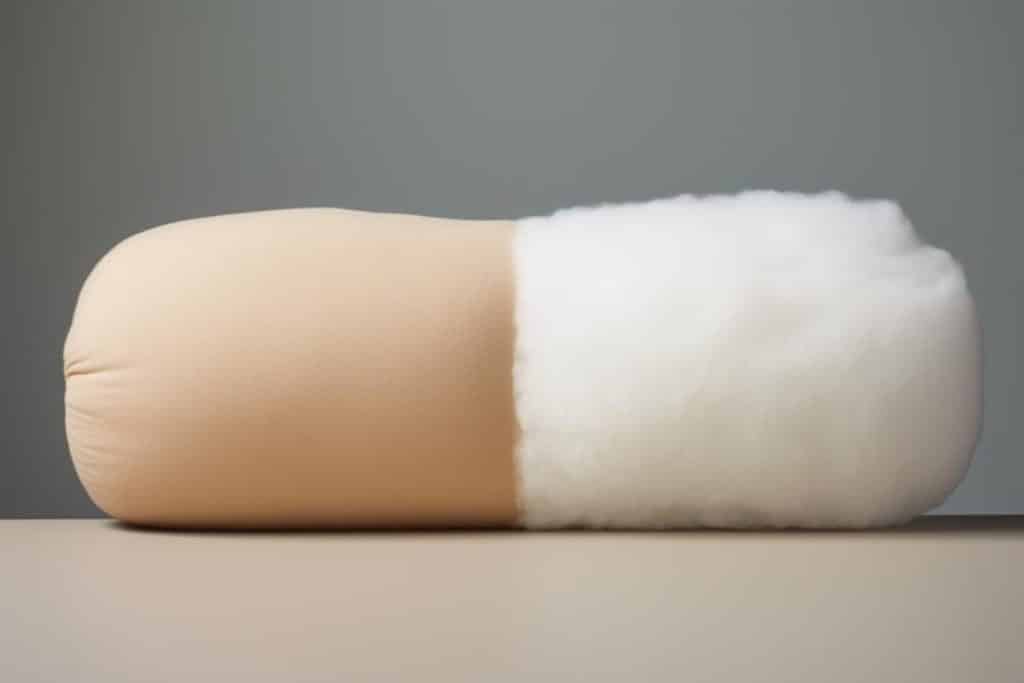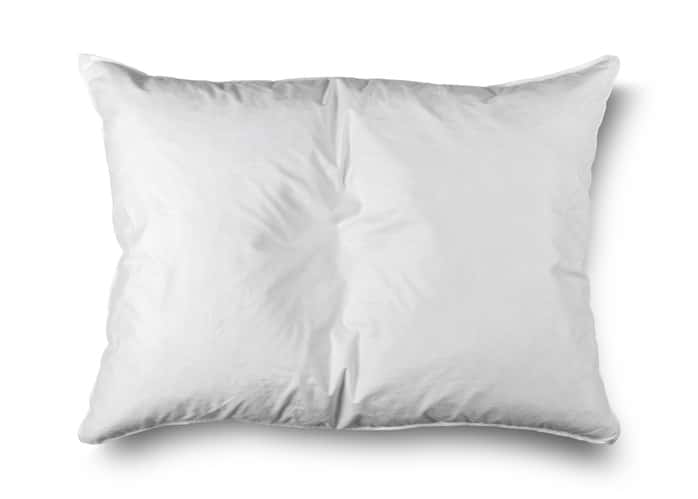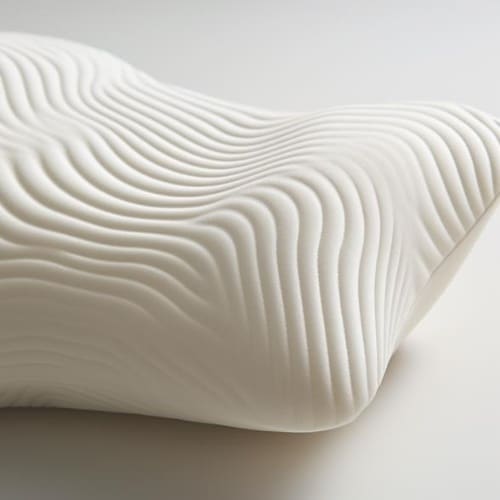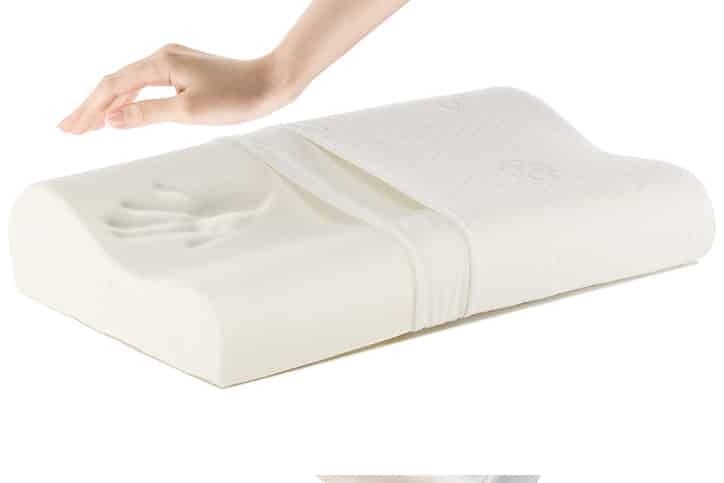Choosing the right pillow is more than just a matter of comfort, it’s also about ensuring a good night’s rest and promoting overall health. The pillow material you choose can impact your sleep quality, posture, and even alleviate (or exacerbate) persistent neck or back pain. Amidst the vast ocean of pillow types and materials, two stand out as popular choices: fiber and foam. But which one reigns supreme when it comes to comfort and support? In this ultimate showdown, we will delve into a detailed comparison between fiber and foam pillows, breaking down their characteristics, pros, cons, and helping you determine which might be the ideal choice for your sleep needs. Buckle up, as we dive headfirst into the battle of pillows!

Summary
Fiber Pillow: The Classic Comfort
Fiber pillows, synonymous with classic comfort, have been the go-to option for sleepers worldwide for generations. Their primary appeal lies in their soft, fluffy feel that can be fluffed up or flattened to obtain the perfect level of firmness. Fiber pillows offer excellent breathability, which helps keep you cool throughout the night. They are also well-loved for their hypoallergenic properties, making them a safe choice for those with allergies. Furthermore, they are generally lightweight and easy to clean, often machine washable, adding to their convenience.
Foam Pillow: The Modern Comfort
On the other side of the spectrum, we have foam pillows, the modern entrants that have swiftly gained popularity. Foam pillows are renowned for their superior contouring capabilities that provide optimum support for the head and neck. This feature makes them a preferred choice for those with body aches or posture issues. In particular, memory foam pillows adjust to the shape of your body, ensuring personalized comfort. However, it’s worth mentioning that these pillows tend to retain heat more than their fiber counterparts. They are typically heavier and may require special cleaning procedures.
The choice between a fiber pillow and a foam pillow often comes down to personal preference. While some sleepers prefer the traditional plushness of fiber pillows, others swear by the supportive contouring of foam pillows. The key is to understand your sleep habits, comfort preferences, and any specific needs or conditions you might have, such as allergies or neck pain.
The importance of personalized pillow fitting is highlighted in a study examining how an in-store pillow fitting process can enhance sleep quality. This research underscores the significance of choosing a pillow that aligns with your individual sleep needs.
What Are Fiber Pillows? Unraveling the Cozy Mystery
Fiber pillows, also known as filled pillows, are made by stuffing a casing with materials known as “fibers”. These fibers can be of various types, ranging from synthetic to natural, each boasting its unique properties and comfort levels.
Synthetic fibers such as polyester are among the most common fill used in these pillows. They are affordable and lightweight, with a plush feeling that closely mimics down. They are also hypoallergenic and easy to clean, making them a great choice for allergy sufferers. However, they might not offer the same level of support or longevity as other types of fibers.
Natural fiber pillows, on the other hand, include materials such as cotton, wool, or down. Cotton pillows and wool fiber pillows are known for their breathability and temperature-regulating properties, helping to keep you cool in the summer and warm in the winter. Down, the soft, fluffy feathers found beneath the tougher exterior feathers of ducks or geese, is considered the crème de la crème of natural fibers. Down pillows are incredibly soft, comfortable, and durable but are more expensive and require careful cleaning.
There’s also a category known as “blends,” which combine different fiber types to maximize the benefits. For instance, a pillow might use a blend of polyester and down to achieve a balance between comfort, support, and affordability.
The type of fiber used in a pillow can greatly influence its feel, support, and lifespan. Therefore, when choosing a pillow, it’s important to consider the kind of fiber that suits your needs and preferences.

Pros of Fiber Pillows: Why They Might Be Your Dream Choice
Hypoallergenic: A Boon for Allergy Sufferers
Fiber pillows, especially those made with synthetic fibers like polyester, are hypoallergenic. This means they resist dust mites, mold, and other allergens, making them an excellent choice for people with allergies or asthma. Sleeping on a hypoallergenic pillow can significantly reduce allergy symptoms and ensure a smooth, uninterrupted sleep.
Versatility: A Comfort for Every Sleeper
The versatility of fiber fillings allows for a wide range of firmness levels, from soft to extra firm. Whether you’re a back sleeper, a side sleeper, or a stomach sleeper, there’s a fiber pillow that has the right level of support for you. This versatility makes fiber pillows suitable for a wide array of sleepers, accommodating their various comfort needs.
Breathability: Keeping Cool for a Better Snooze
Fiber pillows are known for their excellent breathability, which translates into cooler, more comfortable sleep. The fibers allow for good airflow, reducing the chances of heat building up within the pillow. This makes fiber pillows a wonderful choice, particularly for hot sleepers who tend to overheat during the night.
Easy Maintenance: Convenience at Its Best
When it comes to cleaning and maintenance, fiber pillows often come out on top. Many fiber pillows are machine washable, making them easy to clean and maintain. Unlike other pillow types that may require special cleaning instructions, fiber pillows offer convenience that can save you both time and effort.
Affordability: Quality Sleep Without Breaking the Bank
Fiber pillows, particularly those with synthetic fillings, are generally more affordable than other types of pillows, such as memory foam or down. This affordability does not compromise comfort or support, making fiber pillows a cost-effective choice for quality sleep.
Lightweight: Easy to Move and Adjust
Fiber pillows are usually lightweight, which makes them easy to move around and adjust to find your perfect sleep position. This aspect can lead to a more restful and comfortable sleep as you can easily mold and shape the bed pillow to your liking.
Cons of Fiber Pillows: The Flip Side

Despite their immense popularity and comfort, fiber pillows also have their share of downsides.
Durability
One of the most significant disadvantages is that they may not be as durable as foam pillows. Over time, the synthetic or natural fibers in fiber pillows tend to clump together, resulting in uneven distribution that could compromise comfort. Consequently, they may need replacement more frequently than foam pillows.
Less Support
Another potential drawback of fiber pillows is that they may not offer the best support for your head and neck. Unlike foam pillows, they lack the contouring properties that adjust to the shape of your head and neck. This lack of support may lead to discomfort or exacerbate pre-existing neck or back issues, especially for side sleepers or those with particular sleep-related conditions.
Harder to Wash
Maintenance can also be an issue with some fiber pillows. While most are machine-washable, repeated washing can cause the fibers to break down over time, reducing the pillow’s lifespan. Furthermore, not all fiber pillows are dryer-friendly, and some may require time-consuming air-drying.
If you’re dealing with feathers coming out of your down pillows, find useful tips in our article on how to prevent feathers from escaping your pillow.
Specific Allergies
Lastly, it’s worth noting that while fiber pillows are generally hypoallergenic, this may not hold true for all types. For instance, pillows made from natural fibers like down or feather can trigger allergies in some individuals. Therefore, if you have severe allergies, it’s crucial to check the specific materials used in the fiber pillow before making a decision.
What Are Foam Pillows? A Deep Dive into Supportive Slumber

Memory Foam: The Space-Age Solution
Memory foam, initially developed by NASA for aircraft cushioning, is renowned for its superior contouring abilities. This type of foam responds to pressure and heat, molding itself to the shape of your body to provide exceptional support. Memory foam pillows are particularly beneficial for people with neck or back pain, as they help to align the spine and reduce pressure points.
Latex Foam: The Natural Choice
Latex foam pillows, made from the sap of rubber trees, offer a more resilient feel compared to shredded memory foam pillows. They have a bouncy, responsive quality, and do not ‘sink in’ as much as memory foam. In addition to their comfort and support, latex foam pillows are hypoallergenic and resistant to dust mites, mold, and bacteria, making them an excellent choice for allergy sufferers.
Pros of Foam Pillows: The Supportive Sleep Solution
Superior Support: Ideal for Spine Alignment
Foam pillows, especially memory foam ones, provide excellent support for your head, neck, and shoulders. They adapt to the contours of your body, ensuring proper alignment of your spine. This makes them ideal for those suffering from neck or back pain, as well as anyone seeking a more supportive pillow.
Long-lasting Durability: A Worthwhile Investment
Unlike fiber pillows that may clump and lose their shape over time, foam pillows are highly durable. They retain their shape well, providing consistent support for many years, making them a worthwhile investment for your sleep health.
Hypoallergenic: Safe for Sensitive Sleepers
Both memory foam and latex foam pillows are hypoallergenic, resistant to dust mites and mold. This makes them a safe choice for individuals with allergies or asthma, ensuring a clean, allergen-free sleep environment.
Reduces Snoring: A Boon for Light Sleepers
Foam pillows, due to their supportive and contouring properties, can also help reduce snoring. By keeping your neck and head properly aligned, they help maintain an open airway, reducing the chances of snoring and resulting in a quieter, more restful night’s sleep for both you and your partner.
Versatility: A Range of Options for Every Sleeper
Just like fiber pillows, foam pillows also offer a range of options to cater to different sleep preferences. From different types of foam to varying levels of firmness, sleepers can find a foam pillow that perfectly matches their unique comfort needs. Whether you prefer a pillow that molds to your shape, like memory foam, or one that offers a more bouncy feel, like latex foam, there is a foam pillow out there for you.
Pain Relief: Comfort for a Restful Night
Given their superior contouring abilities, foam pillows are often recommended for those suffering from chronic pain or discomfort during sleep. By evenly distributing pressure across the pillow, they can help alleviate pain points and ensure a more restful and comfortable night’s sleep.

Cons of Foam Pillows: Considering the Downsides
Heat Retention: A Potential Drawback
One common complaint about foam pillows, especially memory foam, is their tendency to retain too much heat. This is because memory foam is denser than other materials, making it less breathable and causing it to absorb and retain your body heat. For hot sleepers, this can lead to discomfort and restless nights. Some manufacturers have addressed this issue by incorporating cooling gels or more breathable covers, but heat retention can still be a concern for some.
Off-Gassing: An Initial Hurdle
Another downside is the “off-gassing” that often occurs when foam pillows are new. This refers to the release of a chemical-like smell from the foam, which can be unpleasant. While this smell usually dissipates within a few days of airing out the pillow, it can be a turn-off for some people, especially those who are sensitive to smells.
Concerned about the smell often associated with new latex pillows? Learn more in our article about whether latex pillows have a noticeable odor.
Weight and Firmness: Not for Everyone
Foam pillows tend to be heavier than other types of pillows. This can make it difficult to move or adjust the pillow during the night. Additionally, while some people enjoy the firm support provided by foam pillows, others may find them too hard for their liking. The high level of firmness might not be comfortable for those who prefer a softer, more plush pillow.
Cost: A Pricier Option
Foam pillows are typically more expensive than their fiber counterparts. Memory foam and latex foam pillows, in particular, can carry a higher price tag due to the materials used and the benefits they provide. While many people find the investment worthwhile for the improved sleep and potential health benefits, others may find the cost prohibitive.
Maintenance: A Careful Clean
While foam pillows do not require fluffing like fiber pillows, they can be more challenging to clean. Most foam pillows cannot be machine-washed and must be spot-cleaned instead. This can make maintaining a clean and fresh pillow more time-consuming and laborious. It’s also essential to ensure that the pillow is thoroughly dried after cleaning to prevent mold or bacteria growth.
For detailed instructions on keeping your memory foam pillow in top condition, check out our guide on how to wash memory foam pillows.
The Pillow Face-Off: Comparing Fiber and Foam

Comfort vs Support
Fiber Pillows:
Fiber pillows are often praised for the plush, cloud-like comfort they bring to your sleep. They are typically softer and more malleable than foam pillows, allowing you to adjust and shape them to your liking. However, this softness can sometimes translate into a lack of support, particularly over time as the fiber filling tends to clump together. For those seeking a softer pillow and don’t require significant neck or head support, a fiber pillow could offer a comfortable choice.
Foam Pillows:
On the other hand, foam pillows are renowned for their superior support, especially memory foam variants that contour to your body shape. They provide an excellent balance of comfort and support, maintaining proper spinal alignment and reducing pressure points. However, their firmness and weight might not appeal to everyone. Some sleepers might find foam pillows too hard or heavy, lacking the plushness of a fiber pillow.
For an in-depth look at how memory foam impacts back health, read our article exploring if memory foam is bad for your back.
Fiber vs Foam: A Matter of Preference
Ultimately, the question of comfort and support comes down to individual preference. If you prefer a softer, more adjustable pillow and don’t mind occasionally fluffing it to maintain its shape, a fiber pillow might be your go-to sleep partner. On the other hand, if firm support and contouring ability are high on your priority list, a foam pillow, particularly a memory foam one, could be the answer to your sleep needs. Either way, the key is to choose a pillow that aligns with your sleep preferences and comfort needs.
For a more comprehensive understanding of how different pillow types can influence your sleep health, a systematic review and meta-analysis delves into the effects of various pillow designs on sleep quality and spinal health.
Durability and Maintenance
Fiber Pillows:
Fiber pillows, while soft and comfortable, may not last as long as foam pillows. The fiber filling tends to clump together over time, causing the pillow to lose its shape and support. Regular fluffing can help maintain the pillow’s form, but it’s usually recommended to replace fiber pillows every 1-2 years for optimal comfort and hygiene. As for maintenance, most fiber pillows are machine-washable, making them easy to keep clean.
Foam Pillows:
Foam pillows, particularly those made of memory foam or latex foam, are known for their durability. They retain their shape well over time, with memory foam pillows lasting around 2-3 years and latex foam even longer. However, they require careful cleaning as they cannot be machine-washed. Instead, they must be spot-cleaned and dried thoroughly to prevent mold growth.
Fiber vs Foam: Maintenance and Longevity
When it comes to durability and maintenance, foam pillows generally outlive fiber ones, but they require more careful cleaning. Fiber pillows, while not as long-lasting, offer the convenience of machine washing. As always, regardless of the type of pillow you choose, regular cleaning and proper care can extend its life and keep it fresh and comfortable for many nights of restful sleep.
Health and Hypoallergenic Properties: Safe Sleep
Fiber Pillows:
For those with allergies, fiber pillows can offer a hypoallergenic haven, particularly those made of synthetic down, a type of fiber designed to mimic the softness of real down while resisting allergens. These pillows are often encased in hypoallergenic covers, adding another layer of protection against allergens like dust mites and mold. However, it’s important to note that the effectiveness of these features can diminish over time as the whole down pillow ages and its filling clumps together, creating pockets where allergens can accumulate.
Foam Pillows:
Foam pillows, particularly those made of memory foam or latex foam, are naturally hypoallergenic. Their dense material structure makes it difficult for allergens to penetrate and inhabit these pillows. Moreover, many high quality memory foam pillows come with hypoallergenic covers, providing an additional allergen-resistant layer. However, those with latex allergies should steer clear of latex foam pillows to avoid potential allergic reactions.
Fiber vs Foam: A Matter of Allergen Resistance
When it comes to allergen resistance, both fiber and foam pillows have their strengths. Synthetic down fiber pillows can provide a hypoallergenic sleep environment, but their effectiveness might decrease over time as the pillow ages. Foam pillows, particularly those made of memory foam, offer excellent allergen resistance due to their dense material structure. However, for those with latex allergies, latex foam pillows might not be the best choice. As with any pillow type, maintaining a clean pillow is crucial in keeping allergens at bay. Regular washing or spot cleaning, coupled with the use of hypoallergenic cotton pillow covers, can significantly reduce allergen buildup and promote a healthier sleep environment.
Exploring other hypoallergenic options? See our insights on whether bamboo pillows can be washed for easy care.
Environmental Impact: Eco-Friendly Choices
Fiber Pillows:
Fiber pillows, particularly those made from synthetic materials, often have a higher environmental impact in terms of production and disposal. The synthetic fibers used in these pillows are typically derived from petroleum, a non-renewable resource. Moreover, these synthetic pillow materials often are non-biodegradable, leading to long-term environmental issues when disposed of in landfills. Despite these concerns, some manufacturers are addressing this issue by using recycled materials in their fiber pillows to reduce their environmental footprint.
Foam Pillows:
Foam pillows, particularly memory foam and latex foam, also have considerable environmental implications. The production of a memory foam pillow involves a range of chemicals, some of which are potentially harmful to the environment. Latex foam, on the other hand, can be more eco-friendly if it’s derived from the sap of rubber trees, a renewable resource. However, synthetic latex or blended latex foams may not have the same eco-credentials. Additionally, foam pillows are non-biodegradable, similar to their fiber counterparts.
Fiber vs Foam: Eco-conscious Considerations
When comparing the environmental impact of fiber and foam pillows, there isn’t a clear winner. Both types have their environmental drawbacks, from the use of non-renewable resources and potentially harmful chemicals in their production to issues surrounding their disposal. For eco-conscious consumers, it would be worthwhile to look for pillows made from recycled or renewable materials, or those produced using eco-friendly processes. Some brands offer eco-friendly versions of both fiber and foam pillows, enabling consumers to make a choice that aligns with their comfort needs as well as their environmental values.
To understand more about the eco-friendly disposal of pillows, check out our discussion on whether pillows are recyclable or should be treated as garbage.
Recommendations for Eco-conscious Consumers:
Eco-conscious consumers should consider pillows made from organic or recycled materials. Organic cotton or wool pillows are biodegradable and free from harmful chemicals, making them a more eco-friendly choice. Alternatively, recycled fiber pillows or natural latex foam pillows can be a more sustainable option. Checking for certifications like the Global Organic Textile Standard (GOTS) or OEKO-TEX can provide assurance of the eco-credentials of the pillow. As always, proper care and extending the lifespan of your pillow also contributes to reducing its environmental impact.
The Price Factor: Balancing Quality and Budget
Fiber Pillows: Price Spectrum
Fiber pillows can range from very affordable to quite expensive, depending on the quality of the synthetic fibers used. Low-cost options often use less refined synthetic fibers and may not provide the same level of comfort and durability as their more expensive counterparts. Higher-end fiber pillows, particularly those featuring synthetic down, can cost significantly more due to the quality of the filling and the hypoallergenic properties they often possess.
Foam Pillows: Investment in Comfort
Foam pillows, especially memory foam and latex foam types, are generally more expensive than fiber ones. The cost is often justified by their long lifespan, superior comfort, and hypoallergenic properties. Memory foam pillows, due to their unique pressure-relieving properties and high demand, tend to be on the pricier side. Latex foam pillows, particularly those made from natural latex, can command high prices due to their durability, comfort, and eco-friendly credentials.
Fiber vs Foam: Value for Money
In terms of value for money, both fiber and foam pillows have their merits. Fiber pillows, despite their shorter lifespan, can offer good comfort at a lower price point, making them an excellent choice for budget-conscious shoppers. Foam pillows, while more expensive upfront, often last longer and remain comfortable over time, providing great value in the long run. Consumers should consider their comfort preferences, allergy concerns, and budget when making a decision.
Making a Cost-Effective Choice
When considering the most cost-effective choice, it’s important to not only look at the initial price of the pillow but also its projected lifespan and maintenance costs. A less expensive pillow that needs to be replaced more frequently may end up costing more in the long run than a higher-priced pillow that lasts longer. Furthermore, hypoallergenic and easy-to-clean options might save you from potential health costs associated with allergies. Hence, it’s recommended to consider all these factors, and not just the upfront cost, when making a purchase decision.
Conclusion: Rest Easy with Your Perfect Pillow Choice
Deciding between fiber and foam pillows is not a one-size-fits-all scenario. It largely depends on your individual comfort needs, allergy concerns, budget, and environmental values.
Recap of Key Points:
- Fiber Pillows: These are generally soft and moldable, offering good support for different sleep positions. However, they may flatten over time and aren’t the best for those with allergies unless they are hypoallergenic or frequently washed. They’re affordable but may not last as long.
- Foam Pillows: Particularly memory foam and latex foam pillows, these provide excellent support and contouring for the head and neck, reducing pressure points and aiding in alignment. They’re hypoallergenic but can be pricier than fiber pillows.
- Environmental Impact: Both types of pillows have environmental considerations. Look for pillows made from recycled or renewable materials or those produced using eco-friendly processes to lessen your environmental impact.
- Price: Foam pillows, while more expensive upfront, often last longer, providing value in the long run. Fiber pillows, though cheaper, may need to be replaced more frequently.
Choose Based on Your Needs:
At the end of the day, the perfect pillow is a personal choice. Whether you value comfort, support, affordability, or eco-friendliness, there’s a pillow out there that will meet your needs. Consider all these factors and make an informed decision to ensure restful, rejuvenating sleep night after night. Don’t rush your decision – after all, a good night’s sleep is one of the most important factors for overall health and well-being.
FAQs: Answering Your Pillow Queries
What is the lifespan of fiber and foam pillows?
Fiber pillows typically last around 1-2 years depending on the quality of materials used and how often they’re used. Foam pillows, particularly memory foam and latex foam, can have a lifespan of up to 3-5 years. However, both types of pillows will last longer with proper care and maintenance.
How frequently should pillows be replaced?
The general recommendation is to replace your pillow every 1-2 years. However, this timeline can vary based on the type of pillow, its quality, and how it’s used. Signs that it’s time to replace your pillow include diminished comfort, visible wear and tear, or if you’re experiencing neck or back pain upon waking.
How can I extend the lifespan of my pillow?
Regular cleaning and the use of a pillow protector can help extend the lifespan of your pillow. It’s also recommended to fluff the pillow regularly to maintain its shape and support.
What is the best pillow for someone with allergies?
Hypoallergenic pillows, especially those made from memory foam or latex foam, are often recommended for those with allergies as they resist dust mites and other allergens. Alternatively, fiber pillows with hypoallergenic synthetic fillings can also be a good option.
Is there an eco-friendly foam pillow option?
Yes, natural latex foam pillows are considered eco-friendly as they’re made from sap of the rubber tree, a renewable resource. Some brands also offer foam pillows made from recycled cotton or with plant-based or bio-derived foams as a more sustainable option.
How do I choose between fiber and foam based on my sleep position?
Your sleep position can greatly influence the type of pillow that’s best for you. Side sleepers often benefit from the firm support of foam pillows, especially memory foam, as they maintain the alignment of the neck and spine. Back sleepers and stomach sleepers may find the softer support of fiber pillows more comfortable, as they allow for easier molding and adjustment of the pillow’s shape.
